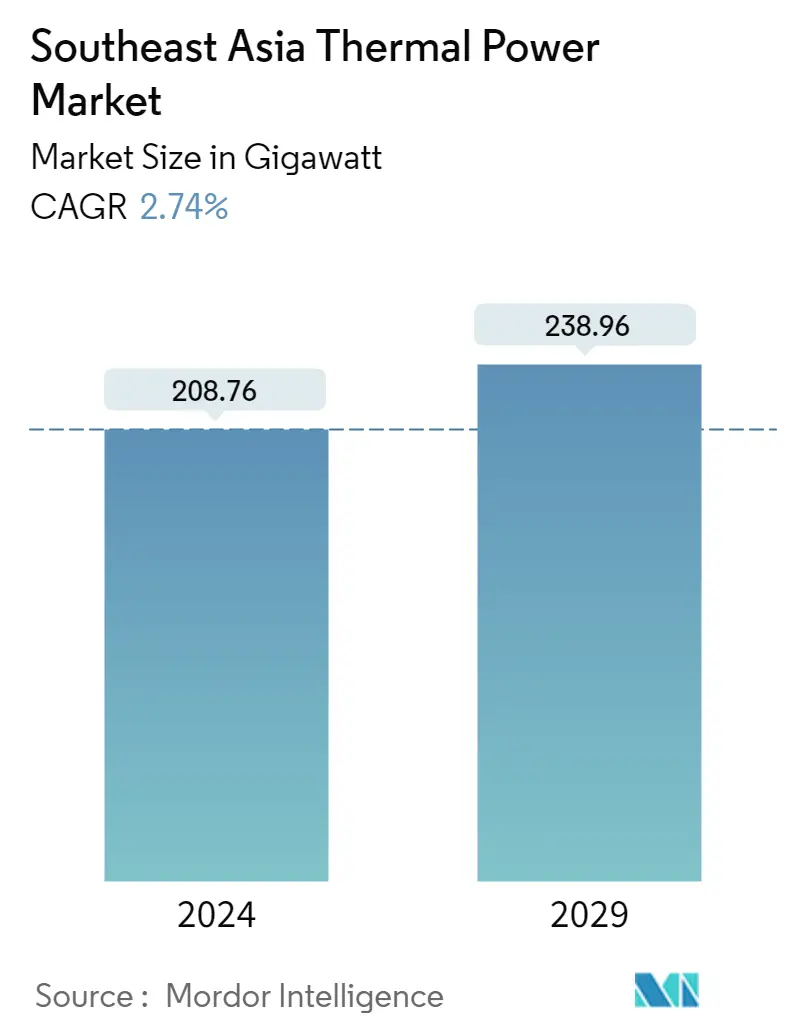Market Size of Southeast Asia Thermal Power Industry

| Study Period | 2021 - 2029 |
| Base Year For Estimation | 2023 |
| Forecast Data Period | 2024 - 2029 |
| Market Volume (2024) | 208.76 gigawatt |
| Market Volume (2029) | 238.96 gigawatt |
| CAGR (2024 - 2029) | 2.74 % |
Major Players
*Disclaimer: Major Players sorted in no particular order |
Southeast Asia Thermal Power Market Analysis
The Southeast Asia Thermal Power Market size is estimated at 208.76 gigawatt in 2024, and is expected to reach 238.96 gigawatt by 2029, growing at a CAGR of 2.74% during the forecast period (2024-2029).
The Southeast Asian thermal power market was adversely affected by the COVID-19 pandemic due to disruptions in the supply chain. However, the market rebounded in 2021, and it is expected to grow steadily during the forecast period.
The rising power demand and increasing investments in the power industry are expected to drive the Southeast Asian thermal power market's growth during the forecast period. For instance, the electricity demand in the region is expected to increase significantly over the next three decades and is expected to reach 2,690 terawatt-hours (TWh) by 2050. Indonesia, Vietnam, Thailand, and the Philippines are expected to register the highest electricity demand during the forecast period.
However, the rapid growth in the renewable energy sector is expected to restrain the growth of the Southeast Asian thermal power market. The energy demand in Southeast Asia is expected to grow by two-thirds between 2019 and 2040, thereby leading to massive investment in new energy generation and transmission, creating ample market opportunities for thermal power generation.
Indonesia is one of the largest economies in Southeast Asia and witnessed the highest power generation in 2021. The nation is expected to dominate the market with upcoming and planned thermal power projects.
Southeast Asia Thermal Power Industry Segmentation
Thermal power generation is the process of generating electricity using direct heat from burning fuel or steam created by burning oil, natural gas, coal, and others to rotate generators and create electricity.
The Southeast Asia thermal power market is segmented by source and cycle. By source, the market is segmented into oil, natural gas, nuclear, and coal. By cycle, the market is segmented into an open cycle and a closed cycle. The report also covers the market size and forecasts for the Southeast Asia thermal power market across major countries. For each segment, the market sizing and forecasts have been done based on capacity (MW).
| By Source | |
| Oil | |
| Natural Gas | |
| Coal | |
| Other Sources (Bioenergy and Nuclear) |
| By Cycle | |
| Open Cycle | |
| Closed Cycle |
| By Geography | |
| Indonesia | |
| Thailand | |
| Malaysia | |
| Vietnam | |
| Philippines | |
| Rest of South East Asia |
Southeast Asia Thermal Power Market Size Summary
The Southeast Asia thermal power market is poised for steady growth over the forecast period, driven by increasing power demand and substantial investments in the power sector. The market, which experienced setbacks due to the COVID-19 pandemic, has shown resilience and is expected to expand as countries like Indonesia, Vietnam, Thailand, and the Philippines ramp up electricity generation. The region's reliance on coal for power generation remains strong, supported by the affordability of coal and the availability of significant coal reserves, particularly in Indonesia. Despite the push towards renewable energy, coal and natural gas continue to play a crucial role in the energy mix, with ongoing and planned thermal power projects further bolstering the market's expansion.
Indonesia stands out as a dominant force in the Southeast Asia thermal power market, with its extensive coal-fired power plants and strategic capacity expansion plans. The country's electricity generation is heavily dependent on fossil fuels, with coal and natural gas being the primary sources. The market is moderately fragmented, with key players such as Indonesia Power PT, Electric Power Development Co. Ltd, and Vietnam Electricity contributing to the competitive landscape. While environmental concerns and a shift towards renewable energy sources pose challenges, the existing infrastructure and upcoming projects are expected to sustain the growth of the thermal power market in the region.
Southeast Asia Thermal Power Market Size - Table of Contents
-
1. MARKET OVERVIEW
-
1.1 Introduction
-
1.2 Installed Capacity and Forecast in MW, till 2027
-
1.3 Recent Trends and Developments
-
1.4 Government Policies and Regulations
-
1.5 Market Dynamics
-
1.5.1 Drivers
-
1.5.2 Restraints
-
-
1.6 Supply Chain Analysis
-
1.7 Industry Attractiveness - Porter's Five Forces Analysis
-
1.7.1 Bargaining Power of Suppliers
-
1.7.2 Bargaining Power of Consumers
-
1.7.3 Threat of New Entrants
-
1.7.4 Threat of Substitute Products and Services
-
1.7.5 Intensity of Competitive Rivalry
-
-
-
2. MARKET SEGMENTATION
-
2.1 By Source
-
2.1.1 Oil
-
2.1.2 Natural Gas
-
2.1.3 Coal
-
2.1.4 Other Sources (Bioenergy and Nuclear)
-
-
2.2 By Cycle
-
2.2.1 Open Cycle
-
2.2.2 Closed Cycle
-
-
2.3 By Geography
-
2.3.1 Indonesia
-
2.3.2 Thailand
-
2.3.3 Malaysia
-
2.3.4 Vietnam
-
2.3.5 Philippines
-
2.3.6 Rest of South East Asia
-
-
Southeast Asia Thermal Power Market Size FAQs
How big is the Southeast Asia Thermal Power Market?
The Southeast Asia Thermal Power Market size is expected to reach 208.76 gigawatt in 2024 and grow at a CAGR of 2.74% to reach 238.96 gigawatt by 2029.
What is the current Southeast Asia Thermal Power Market size?
In 2024, the Southeast Asia Thermal Power Market size is expected to reach 208.76 gigawatt.

